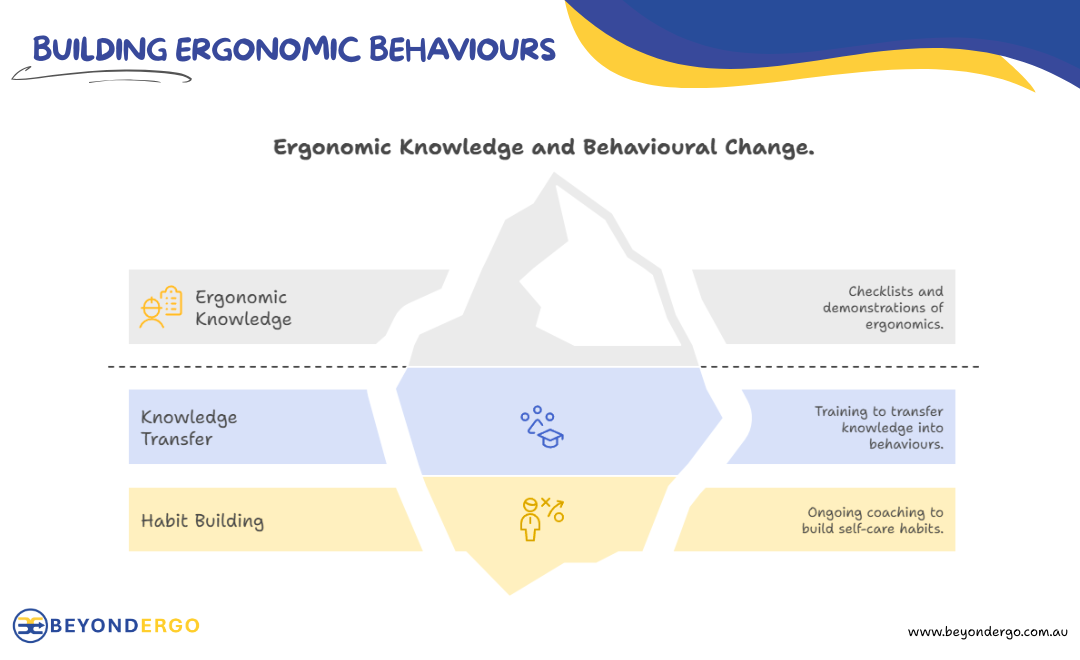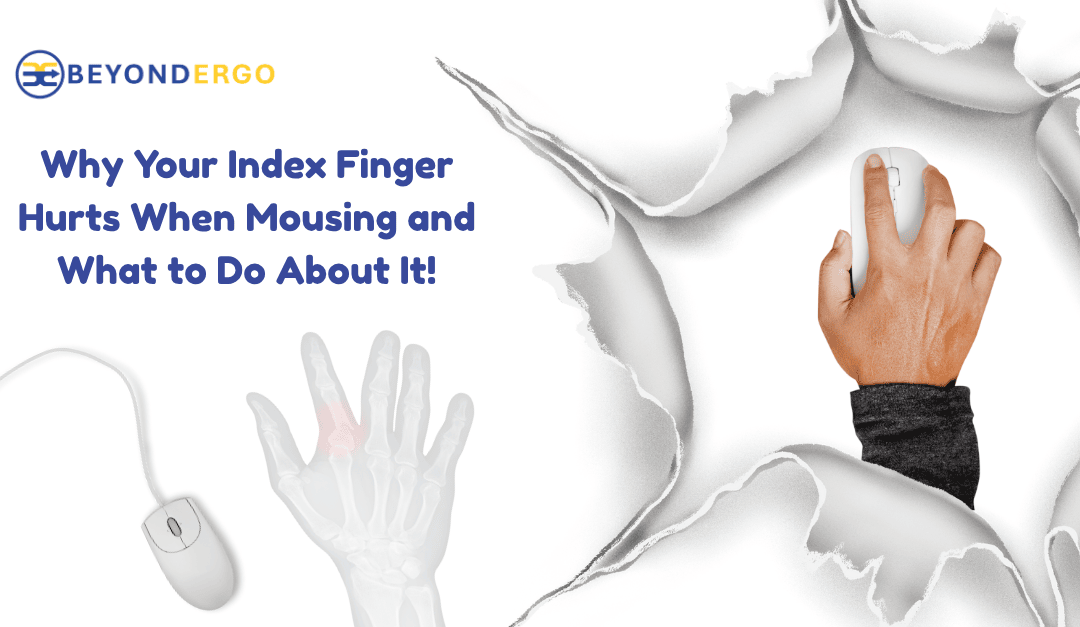Small Changes Project
Discover an always-growing collection of practical resources to help you build a healthier, safer and more engaged workforce.
It all starts with the small changes and little habits that build into self-care competencies – the personal protective behaviours (PPBs) we all need when working in computer-based work environments.
Discover practical tips and fresh insights—click through to the Beyond Ergo YouTube channel for free interviews, webinars, and resources to boost WHS and wellness in computer-based workplaces.
- Visit the Beyond Ergo YouTube channel | For free interviews, webinars, and resources to boost WHS and wellness in computer-based workplaces.
- Roll, Reset, Relax | The simple habit to release muscle tension and reset your posture!
- Work from Home (WFH) Ergo & Self-Care Skills Checklist | Go beyond the basic ergonomic checklist to help remote workers stay fit and productive.
- Free Stretching at Your Desk Guide | Help staff release muscle tension to relieve aches and pain.
Small Changes Checks & Useful Resources
Useful Resources – Government and Health Authorities
The Small Checks To Make Every Day
Telecommuters – Ergo & Wellbeing Checklist
Supporting the Mental and Physical Health of Consultants
Small Changes Videos
The Small Actions To Take Every Day
Take A Break
Save these videos to your phone. Relax your mind while on the treadmill or even meditating
Resources
HSE | Working safely with display screen equipment
- Overview |
As an employer, you must protect your workers from the health risks of working with display screen equipment (DSE), such as PCs, laptops, tablets and smartphones.
The Health and Safety (Display Screen Equipment) Regulations apply to workers who use DSE daily, for continuous periods of an hour or more. We describe these workers as 'DSE users'. The regulations don't apply to workers who use DSE infrequently or only use it for a short time.
- Workstations and assessment
- Work routine and breaks
- Eyes and eyesight testing
- Training and information
Health & Wellbeing Qld
Creating Healthier Workplaces
Click here to discover tools and resources to create a healtheir workplace, including
- The Work Health and Wellbeing Toolkit; A practical guide to developing a successful healthy workplace program
- The Work Health and Wellbeing Interventions Tool; Develop interventions to manage work health and wellcing risks
- The Healthy Workplace Audit Tool; A tool to assess workplace systems and environments and identify areas for improvement
- The Work Health and Wellbeing Online Learning Course; An interactive course for creating business systems to improve the health of workers and workplaces
WA Gov Workplace Health Promotion Toolkit
Australians spend about a third of their lives at work, making the workplace an ideal setting for promoting health and wellbeing.
Click here to discover an amazing array of resources and training programs, including
- How to develop a comprehensive workplace health program
- Quick wins to make your workplace healthier
- Healthy tips for workers
- Online training
- Newsletters and updates
U.K. NHS - ACTIVE 10 | May be easier than 10,000 Steps
Get active
"No matter how much you do, physical activity is good for your body and mind. Adults should aim to be active every day. Some is good – more is better still.
A daily brisk walk can boost your energy, lift your mood and make everyday activities easier.
Try these tools, tips and special offers to move more every day".
Web Link Click Here
Aust Gov - Physical Activity and Sedentary Behaviour Guidelines
Australia's Physical Activity and Sedentary Behaviour Guidelines and the Australian 24-Hour Movement Guidelines
This page contains Australia’s Physical Activity and Sedentary Behaviour Guidelines for adults and older Australian’s and the Australian 24-Hour Movement Guidelines for the Early Years; and the Australian 24-Hour Movement Guidelines for Children and Young People including links to brochures and other resources.
- Research-backed guidelines
- Extensive range of resources
- Regardless of how young or old you are, there are physical activity and sedentary behaviour guidelines available for you.
Beyond Ergo - Roll-Reset-Relax
Reduce neck and shoulder discomfort by 50%
Download this flyer with instruction notes.
As we type or swipe, we build up tension in our neck and shoulders. To release the tension that leads to sore muscles and headaches, we need to do a big movement and consciously relax.
Beyond Ergo - Easy Workstation Checklist
Check these common issues that lead to pain

Self-Care Competencies
For a Unique 21st Century Workforce
Download this illustrated PDF showing solutions for common issues causing pain and possible injuries when working with screens
Beyond Ergo - Working From Home - Ergo & Health Checklist
How to support staff working remotely
Download our FREE 17 page guide that goes beyond ergonomics to support staff working remotely.
Health Line - 11 Signs and Symptoms of Too Much Stress
11 Signs and Symptoms of Too Much Stress
Stress is defined as a state of mental or emotional strain caused by adverse circumstances.
At one point or another, most people deal with feelings of stress. In fact, one study found that 33% of adults reported experiencing high levels of perceived stress (
The condition is associated with a long list of physical and mental symptoms.
This article will look at 11 common signs and symptoms of stress.
Article Link Here
Aust Gov - Exercise and mental health
Health Direct
Exercise has many benefits, not only for your physical health but also your mental health. In your brain, exercise stimulates chemicals that improve your mood and the parts of the brain responsible for memory and learning.
- Benefits of exercise
- Mental health benefits of exercise
- Exercise and the mind
- How much exercise do you need?
- Where to get support
Click2Move supports active and health workplaces
Click2Move supports active and health workplaces in Europe through promote health-enhancing physical activity (HEPA), co-creating digital solutions to sit less and move more to tackle the challenge of occupational sedentarism in a home-office context.

CANADIAN 24-HOUR MOVEMENT GUIDELINES FOR ADULTS
The CSEP Guidelines information hub features the latest updates and resources for the Canadian 24-Hour Movement Guidelines: An Integration of Physical Activity, Sedentary Behaviour, and Sleep.
Physical activity is a foundation for a healthy lifestyle. Yet increasingly, we are seeing that Canadians of all ages are choosing sedentary activities over active ones. Maintaining a healthy lifestyle, with the right balance of physical activity and rest, plays an important role in Canadians’ overall health, well-being, and quality of life, regardless of age.
CANADIAN 24-HOUR MOVEMENT GUIDELINES FOR ADULTS
The CSEP Guidelines information hub features the latest updates and resources for the Canadian 24-Hour Movement Guidelines: An Integration of Physical Activity, Sedentary Behaviour, and Sleep.
Physical activity is a foundation for a healthy lifestyle. Yet increasingly, we are seeing that Canadians of all ages are choosing sedentary activities over active ones. Maintaining a healthy lifestyle, with the right balance of physical activity and rest, plays an important role in Canadians’ overall health, well-being, and quality of life, regardless of age.
WorkCover Qld - Creating healthy and safe computer work
4 videos and notes - 1. Chair Set-Up, - 2. Workstation, - 3. Home Office, - 4. Keep Moving
It's important to think about all aspects of how you work on your computer to stay safe and healthy––no matter where you are working. This means thinking about your equipment, the area where you work, your work activities and your own characteristics such as your height and eyesight needs.
Web Link Click Here
Beyond Ergo - 3 Simple Checks to Reduce Headaches
Spending long hours looking down at a screen, especially when bright and fairly close to your face is hard on your eyes, and your neck, upper back and shoulder muscles.
Read our 2 min blog post here
SafeWork Australia - Infographic: Four steps to preventing psychological injury at work
Infographic: Four steps to preventing psychological injury at work
Page link here
Download as PDF or png file
WayAhead - Recognising and Managing Stress
Recognising and Managing Stress
What Is Stress?
We are all familiar with stress. It is a normal response that we may experience to some extent every day. Stress is the mind’s and body’s way of preparing us to face a challenge. A certain level of stress is necessary to not only function, but to motivate us to reach our full potential. Too much stress, however, can be a health hazard. The first important step ...
Read Article Here
Cornell University - Ergonomic Guidelines for arranging a Computer Workstation - 10 steps for users
Arranging a Computer Workstation - 10 steps for users
Find 10 Steps here
Creating a good ergonomic working arrangement is important to protecting your health. The following 10 steps are a brief summary of those things that most Ergonomists agree are important.
Beyond Ergo - Thinking About a Standing Desk?
Should We Rush To Stand?
Professor Alan Hedge at The Cornell University Ergonomics Web released a review on the possible perils of Sitting and Standing at Work Key points include Sitting for “more than 1 hour …leads to the deposit of fats in adipose tissue rather than these being metabolized...
Read blog here

Beyond Ergo - Avoid Headaches, Neck Pain and Eye Strain
Download our FREE illustrated info sheet to avoid common issues that lead to pain!
Swiping or Typing - Screens cause us pain!
A simple practical suggestion to build the new 21st Century skills we all need to -
Reduce Pain and Chance of Injury

These are easy-to-implement no-cost changes for your
- Work Environment
- Tool placement Ergonomics and
- New wellness behaviours
Download here

WorkCover Qld - Mentally Healthy Workplaces
People as Work
People at Work provides organisations with access to:
- a reliable and valid psychosocial risk assessment tool
- resources to support organisations implementing a psychosocial risk management approach and evaluating the effectiveness of chosen interventions.
People at Work is a psychosocial risk assessment process. It aims to help organisations identify and manage workplace risks to the psychological health of all the people who work in the organisation.
Link to Pager Here
Workplace Health Savings Calculator
How much could your business save?
See the potential savings you can expect from a successful workplace health program by measuring absenteeism and staff turnover.
Link to Web Page Here
The return on investment (ROI) calculator is a tool that assists organisations to estimate an indicative return on their investments in work health and safety (WHS). It provides an indication of whether a particular investment (e.g. a new piece of equipment or an employee wellbeing program) will improve an organisation's bottom line.
ROI is a measure of the dollars returned in benefits from a work health and safety initiative for each dollar invested. For example, a recent study by PricewaterhouseCoopers1 of mental wellbeing interventions found that they returned $2.30 for every dollar invested.
Mental Health Commission of NSW - Evidence Guide PDF
Australian Gov - Head to Health
“Managing my physical health is closely tied up with looking after my mental health.”
- Home
- Welcome
- Meaningful Life
- Mental Health Difficulties
- Supporting Yourself
- Supporting someone else
- Service providers
Regular exercise, a balanced diet, proper sleep, and cutting down smoking, alcohol, and drug use are vital to physical health and mental wellbeing.
Safe Work Australia - National RTW Strategy
The National Return to Work Strategy took effect on 1 January 2020 following its launch in September 2019 and our presentation at the Actuaries Institute Injury and Disability Schemes Seminar in November 2019.
US Gov - Office Ergonomics: Computer Workstation & Mobile Computing
Office Ergonomics: Computer Workstation & Mobile Computing
Page link here
Description:
- An interactive guide for adjusting your computer workstation and mobile computing.
- Increase your workstation and mobile computing comfort and productivity
- Computer Workstation - Covers Chair Adjustment, Workstation Layout, Keyboard & Mouse Placement, and Monitor & Document Placement.
- Mobile Computing – Covers using laptops and other portable devices in the office, at home, and while travelling.
A properly set-up computer workstation can eliminate discomfort and even prevent it from occurring in the first place.
These self-help courses can help you set-up a safe and comfortable computer workstation:
Office Lighting and Computer Use for Eye Comfort
Sit-Stand Workstations, Help for Workers
Sit-Stand Workstations, Help for Employers
Working from Home Offices? Here's some information to help stay comfortable and productive:
Don't bend, don't break: Setting up a safe and healthy workspace for teleworking (F417-289-000)
New mental injury resources from WorkCover to help employers support workers
New mental injury resources from WorkCover to help employers support workers
Page link here
Description:
-
Mental injuries in the workplace are on the rise, and they can sometimes be challenging for employers to navigate.
Research shows employers play a crucial role in an injured worker’s recovery. In fact, workers who feel supported by their employer are up to five times more likely to return to work after an injury and have positive outcomes.
That's why WorkCover Queensland has launched new resources to help employers better manage work-related mental injuries.
The first four videos and factsheets are now available on our Mental injury essentials webpage. These guides answer important questions such as ‘What is a workplace mental injury?’ and ‘How does offering suitable duties benefit my business?’
Over the next few months WorkCover will be sharing more resources so that employers have the tools needed to better support workers and get them back to work safely.
How to relieve neck, shoulder and upper back pain
Headaches and a Sore Neck?
Try these simple changes!
Upper Back Pain?
Check for awkward postures
What are MSD's?
Pain and soft tissue injuries are increasingly common among computer and screen users.
Watch this short video to know the signs an how to protect yourself from a very painful injury that can last for months or even years!
Standing to Work?
How to protect your back at standing workstations
TED-Ed - Why sitting is bad for you - Murat Dalkilinç
Sitting down for brief periods can help us recover from stress or recuperate from exercise. But…
Stretches to Relieve Muscle Soreness
Working with computers and screens is surprisingly hard on your body
Try these simple stretches throughout the day to release tension, reduce muscle pain and help prevent soft tissue injuries.
Choose the Right Shoes
The right shoes will protect your back when standing
Take A Break
Save these videos to your phone. Relax your mind while on the treadmill or even meditating.
20 min Waterfall
15 min Pond
Beyond Ergo Statements
White Paper
Increasing Business Efficiencies through Effective Ergonomic Training

Capability Statement
Discover how we blend office ergonomics training with your health and wellness goals to build the new ergonomics and self-care competencies needed by our multi-screen, multi-workstation and mobile workforce.
Go to the download page here!
Position Paper
This paper argues that the doubts regarding the benefits of office ergonomics have arisen due to the unrealised gap between research and the development of training that successfully translates that research into health, safety and wellness work skills.
Office ergonomics talks, checklists and workstation assessments provide information, not training.
Go to the download pager here
See our posts

Knowledge Without Action: The Hidden WHS Risk in Tick-the-Box Ergonomics
Have you wondered about Ergonomic Behaviours? Have you ever noticed how some workplace training feels... familiar? The slides, the checklists, the reminders about good posture and desk setup. Most ergonomic programs haven’t changed in a decade. They teach what to do —...

Why Your Index Finger Hurts When Mousing — and What to Do About It!
Discover why your index finger hurts from mouse use — and how to fix it. Learn proven ergonomic and movement strategies from Beyond Ergo to prevent tendinitis, RSI, and carpal tunnel pain at work.
Contact Us
Beyond Ergo is based in Brisbane with many of our clients located across South East Queensland. However, we deliver Ergonomic programs, talks and presentations to groups employed in computer-based work (e.g. call centres) across Australia.
Ph: 08 6372 4016
Mobile: 0408 751 379
Email: info@beyondergo.com.au
Postal: PO Box 357, Melville WA 6956, Australia
Street: Address: Level 2, 35 Outram St, West Perth, WA 6005


